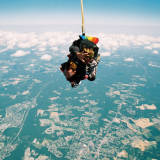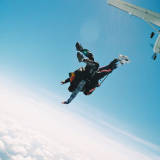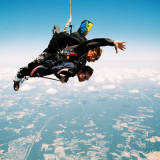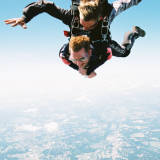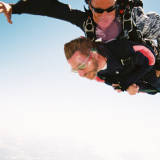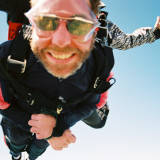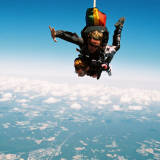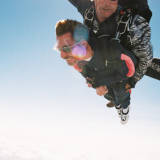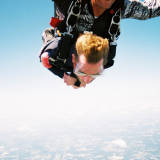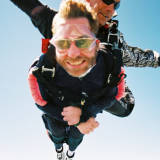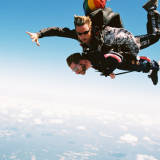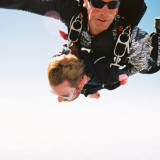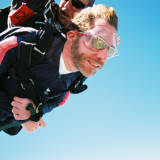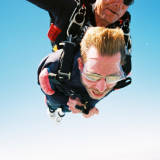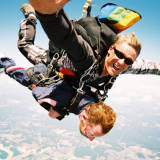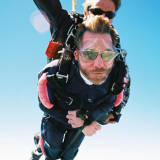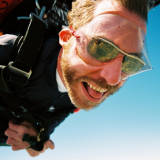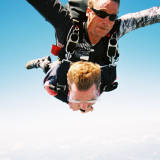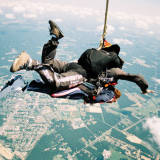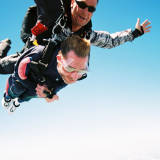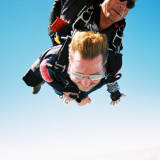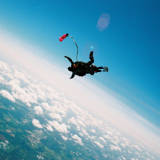-
Content
-14 -
Joined
-
Last visited
-
Days Won
1 -
Feedback
0%
Content Type
Profiles
Forums
Calendar
Dropzones
Gear
Articles
Fatalities
Stolen
Indoor
Help
Downloads
Gallery
Blogs
Store
Videos
Classifieds
Everything posted by admin
-
"Tuesday. I'm going to jump on Tuesday. If the weather holds, that is." Like a teenager, Arthur Stapler's voice cracks with excitement. "It's been a bad spring and early summer here," he chats on, "lots of rain and clouds. I would have done it sooner, but they had a record or something they wanted to get. So Tuesday I will do this. If the weather plays nice." View Rebel's Photo Gallery View Rebel's Video ~19MB!Arthur, known as "Rebel" for reasons which are perfectly clear once you know him, has Multiple Sclerosis . MS is a neurological auto-immune disease which attacks the brain, and disrupts the timely and smooth flow of the nerve ends by destroying the myelin sheath. Diagnosed on his 21st birthday, Rebel completed college, pledged a frat house (ask him about his egg story someday!), married, divorced, married again, and has had 2 separate careers, both as a VP of an automobile dealership and in textiles. Now, Rebel's MS has progressed to the point where he is completely reliant on a powered wheelchair. He still has, however, limited use of his right hand. He's used that hand to reach out and grab his dream of bodyflight. He's going skydiving. "Ever since I was a little boy, I wanted to fly. So I went hunting for a picture of skydiving to put onto my computer, to look at sometimes. Did a google search. Up popped Dropzone.com, and I was sucked in. Like a tornado, but good." He laughs. "All I originally wanted was a picture, and look what happened." Rebel researched dropzones, settling on CrossKeys in Williamstown, NJ. He called them, and talked to them about the possibility of him making a tandem skydive. Without announcing it to family or friends, he arranged possible dates and times, and coordinated with a few conspiring aides to assist him in finding the sky. As the day neared, he sent out invitations to family and friends. He was getting excited, he said, glued to the weather stations and planning. If it wasn't going to be Tuesday, it was going to be shortly thereafter. He was going to fly. His sister Marci said she thought he was crazy at first, and then, "why not? Why not?? I had no real questions about it, I didn't really think about it, I figured the details will come as we go. At first, I didn't even realize it was going to be tandem. I just knew if he wanted it, it was going to happen. That's Arthur. And that's wonderful." It was clear on Tuesday. Beautiful, blue, midsummer day. Rebel didn't tell anyone at his assisted care facility where he was going (they thought he was at the doctors). Rebel packed up and went out of state to CrossKeys. And pulling up at the dropzone was, he said, "interesting." Having never been to a dropzone, he was immediately aware of "the vibe", that feeling of barely suppressed excitement, of manageable exuberance. Amy, his little sister, was there. "My brother became my hero a few years ago, and continues to be so. This is just typical of him. He decides to do something, and then just goes and does it. He sees everything as a surmountable challenge for him. There's nothing he can't do when he decides to do it." Connecting with Tandem Instructor Range Luda, who has lots of experience in bringing physically challenged folk into the sky, Rebel knew he was going with a master. Nothing to stop him now, nothing at all. It was happening. And he felt great. Getting him into the jumpsuit was accomplished, and then Rebel says "I didn't know what to expect next. And man, I was surprised." A specially designed harness was brought out. It strapped the legs together, and immobilized the arms across chest, along with attachment points for the tandem master. "Well, now I know what bondage is. I was looking for ladies in high heels and leather, but they didn't show." He laughed. "I'm kinda glad they didn't, either." Trussed like the family Thanksgiving turkey, Arthur was on his way. Back into the wheelchair, and down the dropzone into the loading area. There sat the 208, waiting. Inviting him into the sky. Motors thrumming, loaded, ready to go. He was going to skydive. First out means last in, and so he got a door seat for his first jump. He recalls wondering if they would shut the door, but distinctly remembers not being nervous. Feeling the anticipation, sure, but not nervous. During the climb to altitude, sitting on the floor with his tandem master behind him, he feels the bindings regularly tighten on the harness, hears slight snicks as the attachments are fastened. He is attached, and ready to go. "Here I am, in a plane, going 2 1/2 miles into the sky, with a bunch of people I have never met, doing something most people never do, and I wasn't nervous. Not one bead of sweat appeared, not one flutter in my stomach. Everyone on that plane was laughing, cheering. I didn't know what to think, what to expect. I was there, though, and that was what mattered. I was going to skydive." Rebel's voice takes on a hint of concern, however. "After awhile, people got quiet, and then started moving around. I thought 'What? Did the engine die or something?' And then a red light went on. They opened the door. I could see the sky. It was huge. And then the light went green. Goggles were put onto my face. We scooched over to the door so my legs dangled over the edge. And then Range asked me if I was ready to skydive. I nodded." With a rocking motion, they slipped from the edge of the door, and out into the blue. Out into the world they flew, no thought, no fear. "We dropped out, and I looked down, and God's honest truth, I only realized I wasn't in the plane was when I saw Erik (the videographer) in front of me." Wonder creeps into his voice. It lowers almost to a whisper. "I'm there. In the sky." Awed. Amazed. And then he recalls thinking "What was everyone telling me about breathing for? I don't have any problem." "I remember feeling weightless," he says, "when I'm sitting in my chair, I'm 134 dead weight. When I was there, I was gliding. I felt weightless. I felt so comfortable, so intense. So peaceful." Merging into the sky, Rebel was free. As they soared and flew through the day, the videographer with them, Rebel knew of the overwhelming bigness of the sky in a way not known to most. "It was so huge, so beautiful, so peaceful", he recalls. "I was outside of the plane - I was in the sky, I was immersed, inside something, blended into something. I knew Range was there, I knew Erik was there, but I was alone. And I was free." Rebel does not remember the canopy opening very clearly. "Poof, soft, and then we could talk. All I could say was 'I want to go again' ". As they danced through the sky under a Strong tandem, Rebel was absorbing everything. "I remember thinking this is what the birds see. I see it like the birds do now. I've looked out of a plane window before, and that is nothing compared to what I saw. Nothing." "I had no concept of time. Forever and too short. I felt just wonderful. It was like a 7 minute orgasm," he laughs, "but free, weightless." Range took him through several spirals, and sliced through the day dancing especially for Rebel. And as they descended, Rebel was grinning. On final approach, Rebel saw his family and friends coming out towards his landing spot. And the landing was absolutely perfect. "It was like a kid playing jacks - soft, mellow, easy." It was over. Rebel recalls "it was like when you go on a rollercoaster, and can sit in the seat and just hand the guy another ticket to go 'round again. I was looking for the ticket guy, but he wasn't there." He received the log entry, his certificate, and bumperstickers. After getting out of his harness and jumpsuit, everyone went over and watched the video on the big screen. "They were giving me hugs," Rebel chuckles. "The President didn't get these hugs. The guy who jumped with the dog didn't get it. I got a lot of love from everyone." Jumpers on his load, other jumpers and dz'ers who were just there, all came over and high-fived him, shook his hand, or hugged him. He was surrounded with the vibe of skydivers; he was now, too, a skydiver. He doesn't know all these people, he says, but he doesn't have to. He felt the love. "I am carrying his pictures around," says his father Michael. "I'm like a Pop with Little League. Everyone has to see them. They show a man who is happy with his life right now, and has something to live for. Arthur is a risk taker but this is a different kind of risk. Not many people...would think of skydiving, but Arthur? Well, that's him. I am very proud." Amy, his little sister, said she was never nervous. "Arthur is my big brother. He does what he says he will. If it takes a bit longer, fine, whatever." Arthur's voice has a quietness, an almost factual insistence, a sureness to it. "What I did today was something which proved that people with disability or illness, whatever physical challenge, can do anything they really want to do. If they want to sit around and be pissed off, cry 'why me', so be it. I am not going to do that; I have never have done it. I have skied on quad skis, I have biked on a tricycle, I am maybe going to get to drive a race car. Now I fly, too. And I am going to do it again." His voice intensifies, if that's possible. "I have learned to make things accessible. I learned how to find answers. If I can't do it now, I'll figure a way to do it later...I learned to realize I could do a lot of things. This was something huge, something important, this skydive. And I did it." "Look, I think of "MS" as two letters. Mighty Special. I can offer people a lot of things. There is someone beyond the wheelchair, beyond the person who can't get up. I can offer many things. I can listen, I can give, I gotta lot of love inside me. MS is only 2 letters. There are 24 other letters left. And I'm busy using those, too." Arthur is still processing the jump, days later. I speak with him, and hear the ecstasy in his voice. "Hey. Tell me again. Why do you want to jump out of a plane?" "Because I can." Yes, Rebel, you can. Special thanks to the folks at CrossKeys: Range Luda - Tandem Instructor Paul Eriksmoen - videographer Lauren Demme- Manifest Jonathan Gordon (Jonno) - Pilot Glenn Bangs- Drop Zone Manager> For more information about Multiple Sclerosis, please go here: National Multiple Sclerosis Society
-
The Neurology Neurosurgical Department of the University of Mississippi Medical Center, under the guidance of Patrick Weldon MD, is conducting an investigation into Injuries Sustained from Hard Openings and is actively researching any skydivers who may have been injured from a hard opening. The chief investigating physician in this study is Dr Patrick Weldon, an avid skydiver, videographer, and WFFC Load Organizer. The purpose of this study is to identify the type, extent, and duration of injuries sustained from hard openings as well as long term effects of these injuries with emphasis on recovery, prognosis, and ability to return to skydiving. Skydiver cooperation is essential to identify common factors from these injuries, and your participation will lead to better understanding of the dynamics involved in parachute openings. Results of this study could lead to improvement in parachute designs. Participants will be under no obligation to travel. Research will be initiated by telephone interviews by a Neurologist or Neurosurgeon. If participant agrees, a physician will review their medical chart and diagnostic procedures (ie. Xrays, CT, MRI etc.) Information on any and all injuries sustained from a hard-opening parachute, minor to severe, is desired. Please note that this is a medical research study only. Physicians and others involved will not in anyway cooperate with any litigation or litiganous activity. Any attempt to use this information for any lawsuit-based purpose will be denied. For more information, or to participate, please contact Dr Patrick Weldon, Department of Neurology, University of Mississippi Medical Center, at (601) 984-5500, fax (601) 984-5503, or via email: Patrick@Flyingthecamera.com This study will follow all applicable HIPA rules and regulations regarding medical research and patient confidentiality.
-
You just landed after throwing a double gainer from a cliff in Moab. Adrenaline surges through your system as you think of the amazing visuals you just saw. As you gather up your canopy, you pause to watch the next jumper exit. After a short delay, he tosses his pilot chute and the canopy deploys offheading. He takes evasive measures but the strikes the wall repeatedly. After finally getting the canopy turned away from the cliff, he lands hard on the talus and tumbles to a stop thirty feet below and doesn't move… Now the real adrenaline kicks in. What do you do? Download this Article IntroductionThe scenario above is a severe one, but all too possible. In the hazardous environment we know as BASE jumping, we often place ourselves in situations which may result in our injury or death. Due to the inherent risk involved with this activity, every time we jump there is a possibility that something will go wrong. Fortunately, the most common BASE injuries are relatively minor and having a basic knowledge of first aid can help dramatically. With immediate care you can reduce the lasting effects of many injuries, and the time it takes to recover. Another goal is to improve the comfort level of the injured. The scene of an accident is not the place to be thinking about learning lifesaving skills. Preparing yourself ahead of time will make you a more confident jumper and knowing your partners have the same skills will go a long way if you yourself happen to be the one needing help. For the purposes of this paper, I have tried to explain thing in layman's terms wherever possible and assume that you have taken a basic CPR course. (Call the American Red Cross or go to www.redcross.org.) 3 Assessment This is where you size up the situation and the extent of the jumpers injuries. This is a process you will use for serious injuries. Your basic assessment should take about one minute. Not slow enough to waste valuable time, but not so fast that you miss important signs. Your minute will be divided into two phases: the Primary survey or ABC' s (15 seconds), and the Secondary survey (45 seconds). Primary: Establishing the severity of the situation. Make the scene as safe as possible. Move anything that may be a risk to you or the injured and get hysterical people out of the area. Send someone for help. Airway. Make the jumper has an airway. If they can talk to you, they have an airway. If not, check yourself. Use the head tilt/chin lift or a jaw thrust. (These techniques can be learned in a basic CPR course.) Breathing. Are they breathing? Put your ear to their mouth/nose area and look for the chest to rise and fall. If no breathing, revert to your CPR training. Circulation. Do they have a pulse? If not, start CPR. Is there profuse bleeding? Deformity. Are there obvious injuries? Expose. Weather conditions permitting, remove the clothes of the jumper (cut preferably) and cover with blankets as needed. Hypothermia is a possibility now and you need to be aware that the jumper may go into shock.Secondary: Eyes, ears, nose, and mouth:a.Eyes; in sunlight, cover the eyes then uncover them and see if the pupils react. At night use a light to check. b.Ears; is there any fluid coming out? Don't try to stop drainage. c.Nose; any bleeding? d.Mouth; look for blood or broken teeth. Teeth can be a choking hazard so remove loose, broken pieces. Neck: Can you see any obvious deformities? Chest: Can you see any section of the chest that moves opposite the rest when the patient breathes? (Broken ribs) Is there any tenderness? Abdomen: Is there any tenderness or does the abdomen seem more rigid than normal? (Internal bleeding) Are they trying to keep you from touching them? Pelvis: Any tenderness? Can you feel bones rubbing or grinding? Someone with a broken pelvis will sometimes feel like they're, "falling apart." Arms: Do you see any obvious fractures? Can you feel any bones grinding? Can you feel a pulse in the wrist? Check circulation by pressing on the fingernails and seeing how fast they get red underneath. Try this on yourself for a comparison. Can they feel you touching their hands? Can they move their arms? Have them squeeze both of your hands at the same time and feel if one side is weak. Legs: Do you see any obvious fractures? Can you feel bones grinding? Can you feel a pulse behind the ankle? (Check behind the big ball on the inside of the ankle.) Check the nail beds. Can they feel your touch? Can they wiggle their toes?By now, you should have an overall impression of how severe the jumpers' injuries might be. Now you can plan the best course of action for the rescue efforts. Redo this assessment every 3-5 minutes until EMS personnel take over. Be sure to report these findings to EMS personnel as it will provide useful information to them.For a quick set of field vital signs: Check the pulse and count beats per minute. Approximate blood pressure can be obtained without a stethoscope or BP cuff. A cool trick: If you can feel a wrist pulse, the systolic pressure is about 80. If you can feel a pulse on the inside of the arm where the bicep and tricep meet, it's about 70. If you can only feel it in the neck, it's about 60. Check breaths per minute.This may not mean much to you but if you can provide EMS workers with a sheet of vital signs detailing every five minutes in the past half hour, it can increase your friends' odds of surviving. This is because it shows the "trend" of vital signs and can give valuable clues about the condition of the jumper. ShockShock can have several different causes but the likely causes in our situations would be trauma to the nervous system, or loss of blood. Shock occurs when tissues and vital organs are not getting enough oxygen from the bloodstream. Symptoms of shock include: Pale, cool, clammy skin Restlessness Nausea/vomiting Rapid breathing Drop in blood pressureThe first step in treating shock is to stop blood loss. Then, cover the jumper with a blanket. As long as injuries don't prevent you from doing so, elevate the feet about 8-10 inches over the heart. They may get thirsty but try not to give anything to eat or drink. If there may be a long delay until help arrives, you can give small amounts of water at room temperature. Even if a jumper doesn't display symptoms of shock, treat for shock anyway. They might not be in shock yet. BleedingThere are three types of bleeding: capillary, veinous, and arterial. Capillary bleeding is the oozing blood you see when you skin your knee. It is minor and not life threatening. Veinous bleeding is blood from a vein. It is dark red and flows out of the wound. Arterial bleeding is pretty obvious since there will usually be an arc of bright red blood spurting out of the body. Arteries carry lots of blood and arterial blood loss can be immediately life threatening. Stop the bleeding: Apply pressure directly over the wound. If you have a clean dressing, use it. If you don't have something sterile, use what you have. A shirt or towel will work. If the wound gets dirty, we can treat it with antibiotics later. If direct pressure fails to stop the bleeding, combine direct pressure with elevating the wound over the heart. If the bleeding still hasn't stopped, apply direct pressure to a pressure point. There are eleven pressure points on each side of the body. If all else has failed, use a tourniquet. The decision to use a tourniquet is a serious one. This will completely stop the blood supply to the extremity involved and may result in that limb being amputated. Use it in a life or death situation. To apply a tourniquet:a.Wrap a band around the limb. Preferably, use something flat and at least one finger wide. A strap from a stashbag will work. b.Tie it in a knot around the limb. c.Lay a stick or similar object directly on the knot and tie another knot over it. d.Twist the stick to tighten the band. Twist it until the bleeding stops. e.Tie the stick in position. Record what time you applied the tourniquet and once it's on, DO NOT remove it. Femur FracturesThe femur is the long bone between your hip and knee. Alongside your femur, lies the femoral artery. The femoral is one of the largest arteries in your body and cutting it can result in bleeding to death very rapidly. For this reason, proper attention to femur fractures is extremely important. Fortunately, the femur is a serious chunk of bone so it takes a lot of force to fracture it.If you suspect that the jumper has a femur fracture, you must not let them attempt to walk on it! After the thigh is injured, the muscles will spasm. If the femur isn't there to support the muscle, the sharp bone ends can cut muscle tissue, nerves, and the femoral artery. The way to prevent this is to apply traction in the long axis of the bone. The easiest method of applying traction is to use a traction splint. (The Kendrick traction splint™ is a very BASE friendly item to have. It costs about $100 and folds into a pouch that will fit inside a hip pouch or cargo pocket. If you were sitting there with a femur fracture I could offer you one for a couple thousand dollars and you'd accept.) To apply traction, pull straight on the ankle. Imagine trying to stretch the leg and make it longer. You will need to keep constant traction until an actual traction splint is available. It is very important that you never let up the tension or else serious damage may result. If the shoe comes off, the resulting rebound will be excruciating and bad things will happen. For this reason, remove the shoe on the broken leg. The jumper won't be walking anyway. SplintingSplinting is not really a science. When a bone breaks, the ends are usually very sharp. When these sharp edges move around, you can damage muscle tissue, nerves, and blood vessels. In order to prevent this, you splint the affected bone to immobilize it. Sometimes, you use whatever is available. There are two classifications of fractures, closed fractures and open fractures. Closed fractures include any fracture where the bone does not break the skin. In such instances, proper treatment includes immobilizing the fracture and seeking medical attention. Open fractures occur when a bone breaks through the skin. Signs of a fracture include: A bone end sticking out of the body, A grinding feeling at the site of the suspected fracture, Deformity of the limb, Loss of ability to move the limb, Loss of pulse or sensation, Muscle spasms.Your first step in treating a possible fracture is to stop and take a deep breath. Few fractures are life threatening unless they are mishandled. If there's no apparent life threatening injury, the best approach is a slow methodical one. Cut away clothing from the area and control any bleeding. If you find an open fracture, treat it like any other wound. Generally, you don't want to attempt to straighten out a broken limb. Don't try to realign the bones yourself. There are exceptions to this. If the limb has no pulse or is losing color, you may need to reduce the angle of the fracture to restore circulation. If you need to transport the jumper over rough terrain, a limb sticking out to the side will make things difficult. In these situations, not splinting would be more dangerous. IF YOU DECIDE TO ADJUST A FRACTURE, keep in mind that the sharp end can do major damage to the surrounding tissues so limit movement as much as possible. Also, have someone hold the jumpers arms so you don't catch a right hook. The goal in splinting is to immobilize the bone that is broken. You should try to immobilize the joint above and below the fracture. Find something to use as a splint. Most sites where we jump are in wooded areas so there is usually a variety of sticks and branches to choose from. If possible, pad the splinting materials with a towel or shirt to take up the space between the limb and the splint. This will also improve the comfort of the jumper. Use your imagination and you can usually come up with a splint for most fractures. Forearms can be fractured when you try to catch yourself during a less-than-graceful landing. Fractured forearms should be splinted with a natural curl of the fingers. Place a roll of gauze, or something similar in the palm of the hand. This will go a long way to improve comfort. If you suspect fractured ribs, you can pad the chest and gently wrap it. Placing the arm on the affected side into a sling helps. Try so calm the jumper and have them sit down until help arrives. Limit movement since a fractured rib can puncture a lung. If you suspect a skull fracture, DO NOT place pressure on the head. Monitor level of consciousness and do not give morphine! Joint injuriesDamaging joints is a constant threat to BASE jumpers. Ankles are the most frequently injured joints skydiving, BASE jumping, and most sports. There's a saying that goes, "An ounce of prevention is worth a pound of cure." This applies to us because it is pretty easy to reduce the number of ankle injuries. Wearing an ankle brace is an easy and effective measure to prevent hurting your ankles in a sketchy landing. They're available at any sporting goods store. A simple low-grade sprain can keep you grounded for a weekend. A serious sprain can keep you from jumping for a year or longer. If you break a bone, it will usually heal stronger than it was before you fractured it. Ligaments, tendons, and other soft tissues may never completely recover from injuries. Ask anyone who's been jumping for a few years. If a jumper injures a joint in the field to the point that it will not bear bodyweight, you should treat it as a fracture until an x-ray can prove otherwise. Splint it and proceed to the nearest hospital for evaluation. All Sprains can be treated with the acronym, R.I.C.E. Rest: stay off the affected joint and give it time to heal. Ice: apply ice, cold packs or frozen vegetables to the joint. Peas work well because they will conform to the shape of the joint. Just don't eat them after several freeze/thaw cycles. Compress: wrap the joint firmly but not too tight. An ACE wrap can is ideal. If your fingers or toes turn purple, it's too tight. If you squeeze your nail-beds, the color should return immediately. If not, re-wrap more loosely. Elevate: Kick back and have a cold one. Try to keep the injured joint at about heart level.This regimen can be supplemented by taking Motrin (ibuprofen) or Aleve (naprosyn). Follow dosing directions on the package. Both are anti-inflammatories and will help with the pain. If this treatment isn't working, it might be a good time to see a doctor. SummaryThis paper is by no means, a complete set of first aid information for the BASE jumper. In addition to reading this paper, I highly recommend enrolling in a CPR class, a basic first aid course, and an EMT Basic course. Most junior colleges offer an EMT course and CPR is usually included. These classes will show you how to approach an injury and decide on the most appropriate course of action. First aid is a skill-set we hope to never need. The harsh reality of our sport is that there will be more injuries, and there will be more fatalities. Hopefully someday BASE jumpers will stop being injured and killed. Until that day comes, we all need to know what to do when accidents happen. ---Dexterbase Download this article



